INDEX
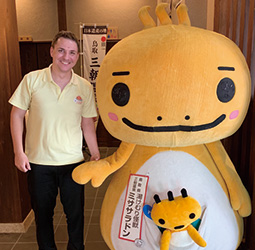
Anthony Lieven with the Misasa Onsen mascot, Steam Monster Misasa Radon 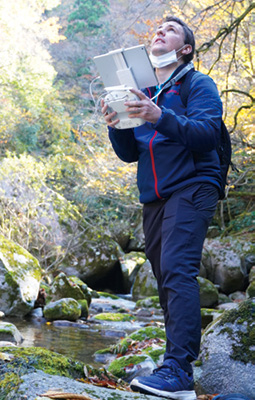
Anthony taking photos of Misasa Onsen with a drone 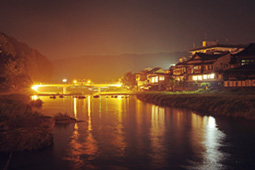
The night view from Misasa Onsen along the Mitoku River
June 2021
A Frenchman Sharing His Passion for a Hot Spring Town

Anthony Lieven, a Frenchman who was fascinated by and moved to Misasa Town in central Tottori Prefecture, is working to tell many people around the world about the allure of this hot-spring town.
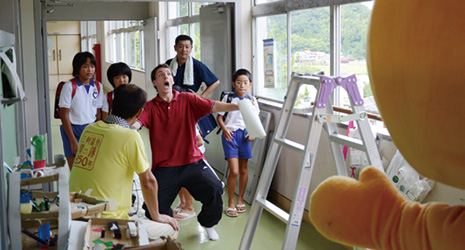
Misasa Onsen in Misasa Town, central Tottori Prefecture is a small hot-spring district in the mountains along the Mitoku River. Misasa Onsen is said to have been discovered when a pilgrim to Mt. Mitoku, a holy place in Shugendo, saved the life of a white wolf some 850 years ago. It has been designated as a Japan Heritage site by the Agency for Cultural Affairs (see Highlighting Japan back page, September 2020).
“I love the scenery. I love the hot springs. I love the kind character of people in the town. Stating each of these things I love about Misasa is not enough because I feel so much more. The relationship is a bit like falling in love with someone and eventually living together. Misasa is a town that I have special feelings for.” So says Anthony Lieven, a Frenchman who has lived in Misasa for eight years.
Anthony became interested in Japan as an elementary school student when his father recommended that he watch Kurosawa Akira’s Seven Samurai, a film that left a deep impression on him. After becoming a university student, he chose to study Japanese because he wanted to learn about Japanese culture through film. In his second year, he went on a one-month trip to Japan and then had the chance to study for a year at Kansai University. After earning his master’s degree in France, and coming to like Japan more and more, Anthony applied to and was accepted into the JET Programme, through which Japanese local governments employ people to promote international exchange. He took up his post in Misasa in 2011.

“My first impression was that it was more rural than I had expected,” says Anthony. “It’s a town with so much nature and almost covered in woods. The green of the trees soothes you wherever you go. I felt I wanted to live in this town for a long time.” He adds with a laugh, “When I first met my colleagues at the town office, I was told I look like the actor Tom Cruise, so I said, ‘I get that a lot,’ and everyone laughed.”
Misasa Onsen is called a “radon spring” that is one of the most radon-rich in the world. Radon springs are said to energize your cells, boost your immunity and alleviate pain. Radon, a gas, is the decay product of radium. Since the discoverers of radium were the French physicists Marie Curie and her husband, Pierre, Misasa Town has been holding the annual Marie Curie Festival since 1951, expressing the town’s gratitude to the benefits of the hot springs and Curie’s accomplishments. They also made a bronze statue of Madame Curie to honor her publicly. Since then, Misasa has deepened its exchange with France, becoming the twin town of Lamalou-les-Bains, a famous hot-spring area in southern France, in 1990. The coordinator for international relations (CIR) at the Misasa Town office has also always been French and Anthony is the 10th person to have this position.
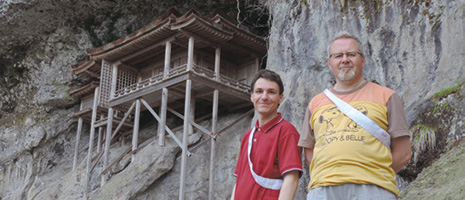
During his five years in office, Anthony organized French-language workshops, prepared exchanges with the twin town, and was otherwise active as the CIR. Furthermore, he directed two short movies: Misasa shonen monogatari (Misasa’s Children’s Adventures), featuring the children of Misasa, and Radonna ichinichi (A Radon Day), featuring Misasa Onsen’s mascot, Steam Monster Misasa Radon. These works were made to commemorate the 850th anniversary of the opening of Misasa Onsen and were covered by many media outlets, including newspapers and TV. Anthony explains, “At the 2013 showing of Misasa shonen monogatari, I was moved to see all the seats in the town cultural hall were taken. The elementary school students who were in the play are high school students now, but we are still in touch with each other.”
After finishing his term, Anthony left Misasa temporarily but because he felt so strongly that he wanted to return to Misasa, he applied to join the Local Vitalization Cooperator Program, which conducts activities for local governments, and started working for the Misasa Onsen Tourism Association in 2019. Anthony’s job today involves communicating information in Japan and abroad as well as dealing with inbound tourism. The number of inbound tourists in 2018 was 20,000, although it has dropped to almost zero owing to COVID-19. However, says Anthony, “COVID-19 is an opportunity for people’s perceptions to change and maybe it will create a demand for calm and quiet environments like Misasa Onsen in future tourism,” so he is working extra hard to prepare for the time when travel returns to normal.

Year round, Misasa Onsen is filled with the calm tranquility of the mountains. In summer, there are the clear and beautiful croaks of the Kajika frogs and the Genji fireflies that dart about. For those planning a long trip to Japan in the post-COVID future, Anthony recommends including Misasa Onsen on your itinerary to refresh and wash away your travel weariness. Anthony says, “I really want people to visit Misasa and have the same experience I had and which led me to develop such a strong attachment to Misasa.”

